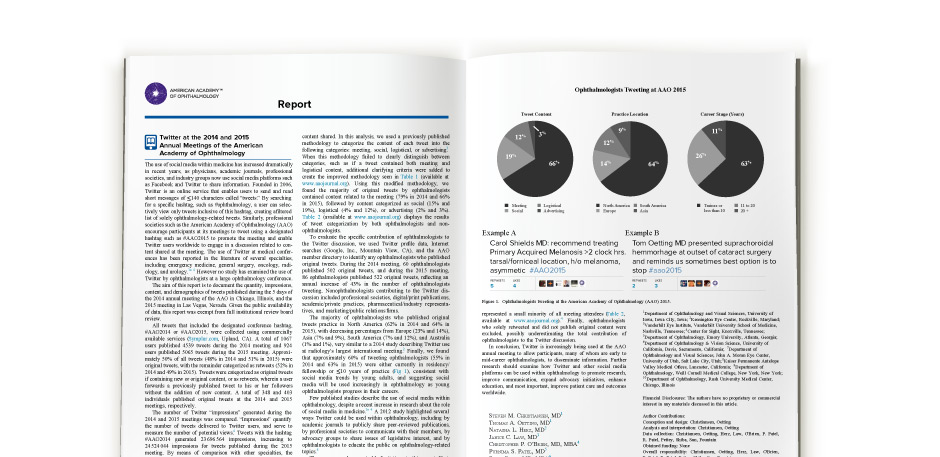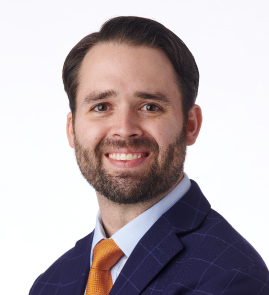Published! After countless hours of work, our research on Twitter at the Annual Meetings of the American Academy of Ophthalmology is now e-published online in the journal Ophthalmology (to be in print soon). For those non-ophthalmologist readers, Ophthalmology is the top clinical journal in our field; this article being published here demonstrates the increased relevance of social media within medicine and ophthalmology, and is a huge success for all who believe social to be an important communication tool today.
Here I will share a few highlights of the paper, but please do not stop here…go on to read the article in its entirety by clicking THIS LINK HERE (it’s free to download if you are a ResearchGate member!), and please, be a good social media citizen, and share, share, share!
Background
Twitter is increasingly being used within medicine to share information between physicians, patients, researchers, professional societies, and industry representatives. Perhaps the best example of Twitter in medicine is at large medical conferences, where meeting participants engage in an online discussion regarding content being presented at the meeting. The use of Twitter at medical conferences has been examined in many specialties; this article is the first to discuss, in detail, the use of Twitter at a large ophthalmology conference, in this case the most widely attending meeting in our specialty, the American Academy of Ophthalmology Annual Meeting.
Methods
All tweets with the hashtag #AAO2014 or #AAO2015 were collected for the five days of each meeting. We separated tweets into retweets and original tweets, and then analyzed the content of each tweet using a previously published methodology, based on whether the content was meeting-related, social, logistical, or advertising. Finally, we examined the demographics of any ophthalmologist who published tweets during the meeting using the designated hashtags in order to determine their primary practice location and their career stage.
Study Highlights
For complete details, please read the full article (it’s <1000 words!), but here are a few highlights.
- 4539 tweets were published during AAO 2014 and 5065 during AAO 2015
- Nearly 50% of all meeting tweets were original tweets and 50% were retweets
- Total impressions (potential tweet views) were >23.5 million during AAO 2014 and >24.5 million during AAO 2015
- Ophthalmologists primarily tweeted content related to the meeting itself (79% in 2014, 66% in 2015), followed by content that was social, logistical, or advertising.
- The number of tweeting ophthalmologists increased by over 43% from the 2014 to 2015 meetings.
- The majority of tweeting ophthalmologists practice in North America (62%, 64%), followed by Europe, Asia, South America, and Australia.
- Approximately 60% of tweeting ophthalmologists were either currently in residency/fellowship or <=10 years in practice.
Conclusions
Sorry, but I am just too excited about the publication of this research to give away all the conclusions here. Go read the article (click below, it’s temporarily free to download!), and come back to share your thoughts!
Thank You! A few much-deserved thank you’s.
Thomas Oetting, MD: The pioneering leader of social media in ophthalmology, with tens of thousands of Facebook followers, Dr. Oetting is my residency program director, mentor, friend, and Yoda. His support of my “non-traditional” passion for blogging and social media was the fuel and energy behind this paper.
Co-authors: The ten co-authors whose names I am honored to accompany are also all members of the Young Ophthalmology Committee with me. Their research experience and social media savvy provided valuable insights throughout every step of the publication process.
Ophthalmology (the “blue” journal): I am absolutely humbled and honored to have this article published in this, the premier ophthalmology journal. The acceptance of this article by Ophthalmology demonstrates the relevance of social media within medicine and ophthalmology. The editorial staff and reviewers provided spot-on criticism and cautious encouragement, and demonstrated just why this is the premier journal in our field.
Social media supporters: Brian Vartebedian (twitter), Alex Djuricich (twitter), Ryan Madanick (twitter), and Amalia Cochran (twitter). Without their even realizing it, these mentors and social media friends provided much-needed encouragement at various stages of this research. These physician-mentors are not only wonderful clinicians, but their thought-leadership and prior research in the world of healthcare social media, helped set the stage for this publication, and we cannot thank them enough.
The citation-earning and the un-cited but deserving: Unfortunately this article only allowed five references, but we greatly appreciated the work of so many others! Here are just a few.
Djuricich AM, Zee-Cheng JE. Live tweeting in medicine: ’Tweeting the meeting’. Int Rev Psychiatry 2015;27:133–9. An outstanding review of peer-reviewed literature within multiple specialties discussing this idea of twitter use at medical conferences, aka “tweeting the meeting.” (link)
Hawkins CM, Duszak R, Rawson JV. Social media in radiology: early trends in Twitter microblogging at radiology’s largest international meeting. J Am Coll Radiol 2014;11:387–90. A great paper on Twitter at a large radiology meeting. (link)
Neill A, Cronin JJ, Brannigan D, et al. The impact of social media on a major international emergency medicine conference. Emerg Med J 2014;31:401–4. This paper was extremely helpful, as it provided a framework for categorizing tweets. After reviewing many papers with many different categorization methods, I felt the authors of this paper had the best method, and in an effort to further provide a foundation for future research in this area, attempted to follow their guidelines as closely as possible. (link)
Wilkinson SE, Basto MY, Perovic G, et al. The social media revolution is changing the conference experience: analytics and trends from eight international meetings. BJU Int 2015;115:839–46. We greatly appreciated this article for its attempt to compare apples with apples by analyzing meeting and twitter metrics across multiple specialties. This paper was a sort of meta-analysis of twitter at medical conferences, and was very helpful. (link)
Micieli R, Micieli JA. Twitter as a tool for ophthalmologists. Can J Ophthalmol 2012;47:410–3. This Micieli duo has published (to this point) essentially all of the literature on social media use within ophthalmology. Their pioneering papers on social media as a legitimate communication method in ophthalmology will hopefully be cited by many in the future. I look forward to meeting them one day.(link)
Cochran, A. Kao, L. S., Gusani, N. J., et al. Use of Twitter to document the 2013 Academic Surgical Congress. J Surg Res 2014;36-40. Dr. Cochran was one of my medical school faculty and has been a huge support for this research from day 1. On more than one occasion she provided suggestions for research methods, and when I felt this project had hit a brick wall, her encouragement helped topple that seemingly indestructible wall. (link)
Twitter at the 2014 and 2015 AAO Annual Meetings; read the highlights and download the full text here @aao_ophth #hcsm @eyesteve Click To Tweet









Twitter is the best for being informative , sharing info , getting interacted , and last but not the least it’s a place of little bit socialization too. Too much hashtag sometimes kill my times . but as a whole it’s the one media ophthalmogist should use more than ” facebooking “!
Thanks for your comment, Dr. Choudhury! I absolutely agree with you about Twitter being informative and social! It can be a great balance between professional education and comaraderie!